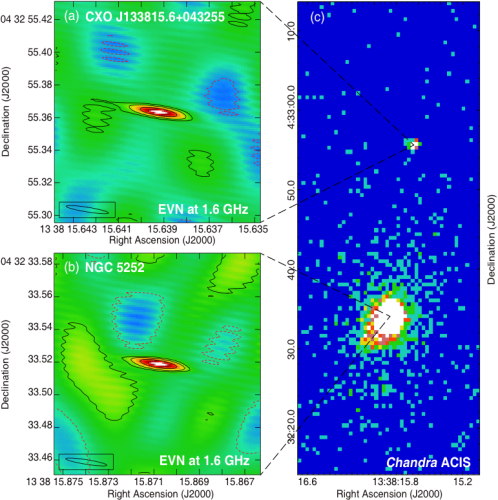
Astronomers from China and Europe have identified a pair of active supermassive black holes in the nearby giant spiral galaxy NGC 5252.
It is believed that every galaxy hosts a supermassive black hole in its nucleus, that is at least million times more massive than the Sun. The evolution of galaxies and their central black holes are closely linked, according to observations. Cosmological simulations suggest that giant galaxies grow through merging with other galaxies, and this process will result in a large number of dual - or even multiple - supermassive black holes in the centre of some galaxies. There are however only a small number of confirmed cases. Pairs of active black holes that grow by attracting gas from the interstellar medium (called accretion) are quite hard to find observationally.
The very long baseline interferometry (VLBI) technique might help in this. Actively accreting black holes - under certain conditions that is still largely unknown - produce relativistic beams of plasma called jets. The base of these jets emit radio waves. These are unusually compact and bright in appearance, compared to other sources of radio emission. The European VLBI Network (EVN) is therefore a great tool to verify if a radio source in a nearby galaxy is related to an active supermassive black hole - taking into account supporting evidence from other wavebands as well.
NGC 5252 is about 320 million light years away from the Milky Way. At the centre, it has an active galactic nucleus with a supermassive black hole, recognized by its optical, radio and X-ray properties. A second very luminous X-ray source, catalogued as CXO J133815.6+043255, was found in the outskirts of NGC 5252 last year. An international team led by Dr. Jun Yang from Onsala Space Observatory of Sweden carried out European VLBI Network observations. They showed that this powerful X-ray source appears quite compact even when looking at the radio waves with the VLBI technique with superior resolution. All the available data point to an origin of the radio emission in a supermassive black hole, just like the one in the galaxy nucleus.
These pairs are very rare, but we expect to see more of them as the sensitivity of the EVN improves thanks to the new telescopes continuously added to the array, and the increase of the data rates that the EVN correlator at JIVE can handle.
Additional information
The results have been published by Oxford University Press in a paper in the journal Monthly Notices of the Royal Astronomical Society, "NGC 5252: a pair of radio-emitting active galactic nuclei?", by X.-L. Yang, J. Yang, Z. Paragi, X. Liu, T. An, S. Bianchi, L.C. Ho, L. Cui, W. Zhao, X.-C. Wu, MNRAS Letters, doi: 10.1093/mnrasl/slw160 (http://mnrasl.oxfordjournals.org/lookup/doi/10.1093/mnrasl/slw160)
Figure 1 The pseudo-colour images of the pair of supermassive black holes observed by the European VLBI Network (left) in the radio band and Chandra (right) in the X-ray band.
